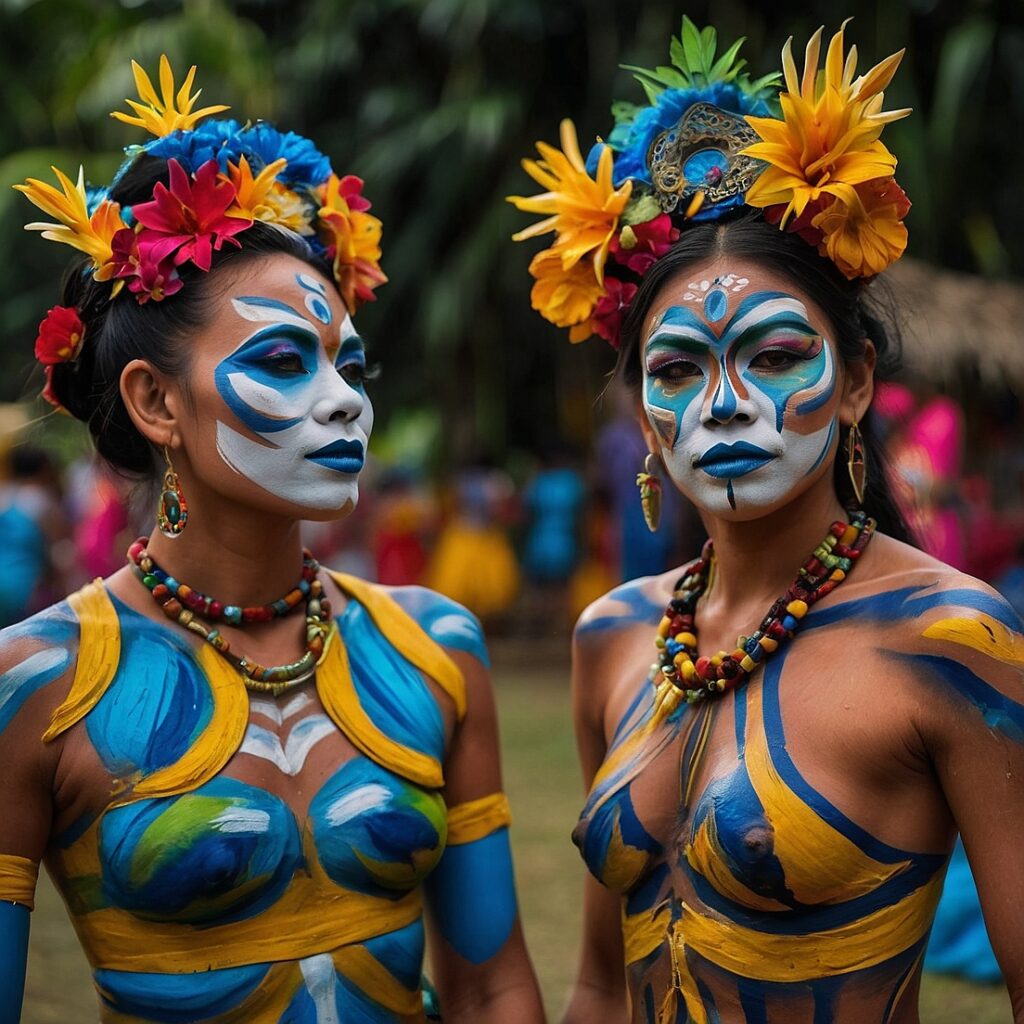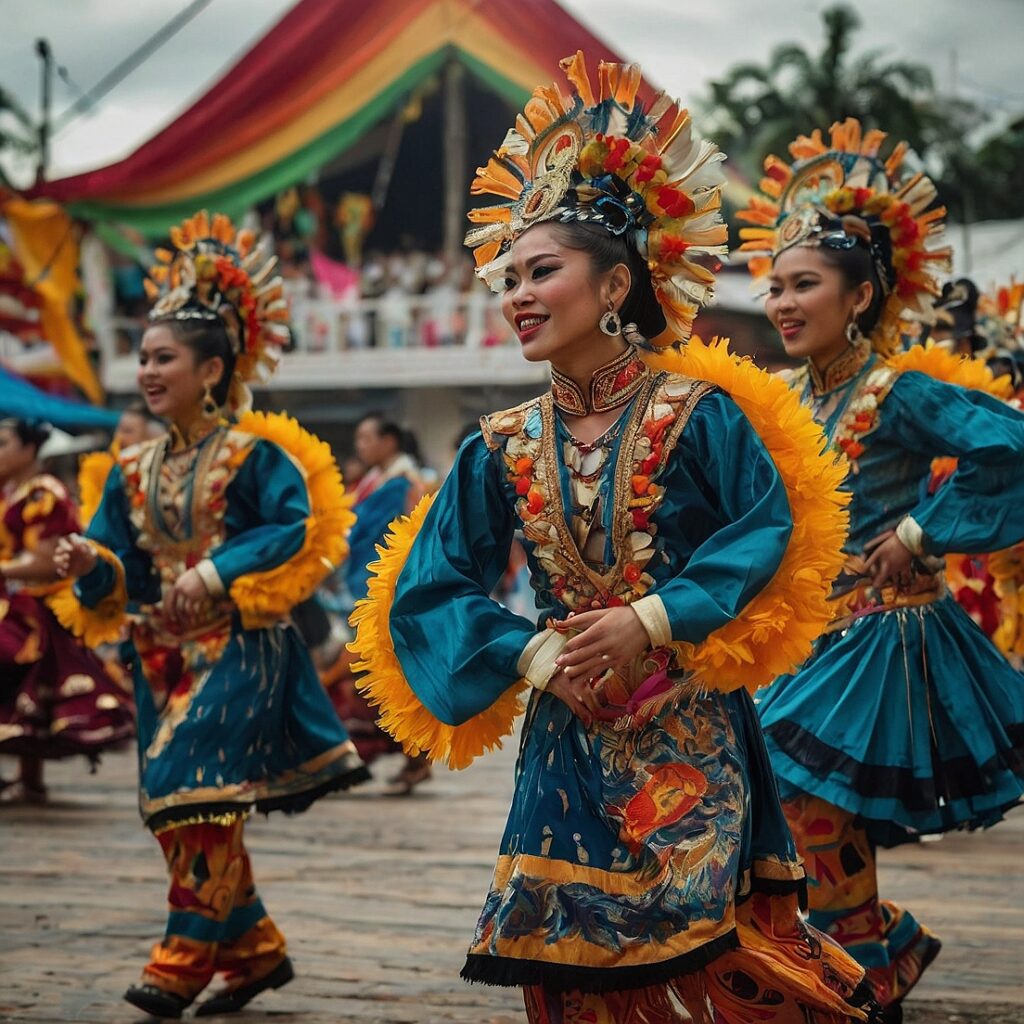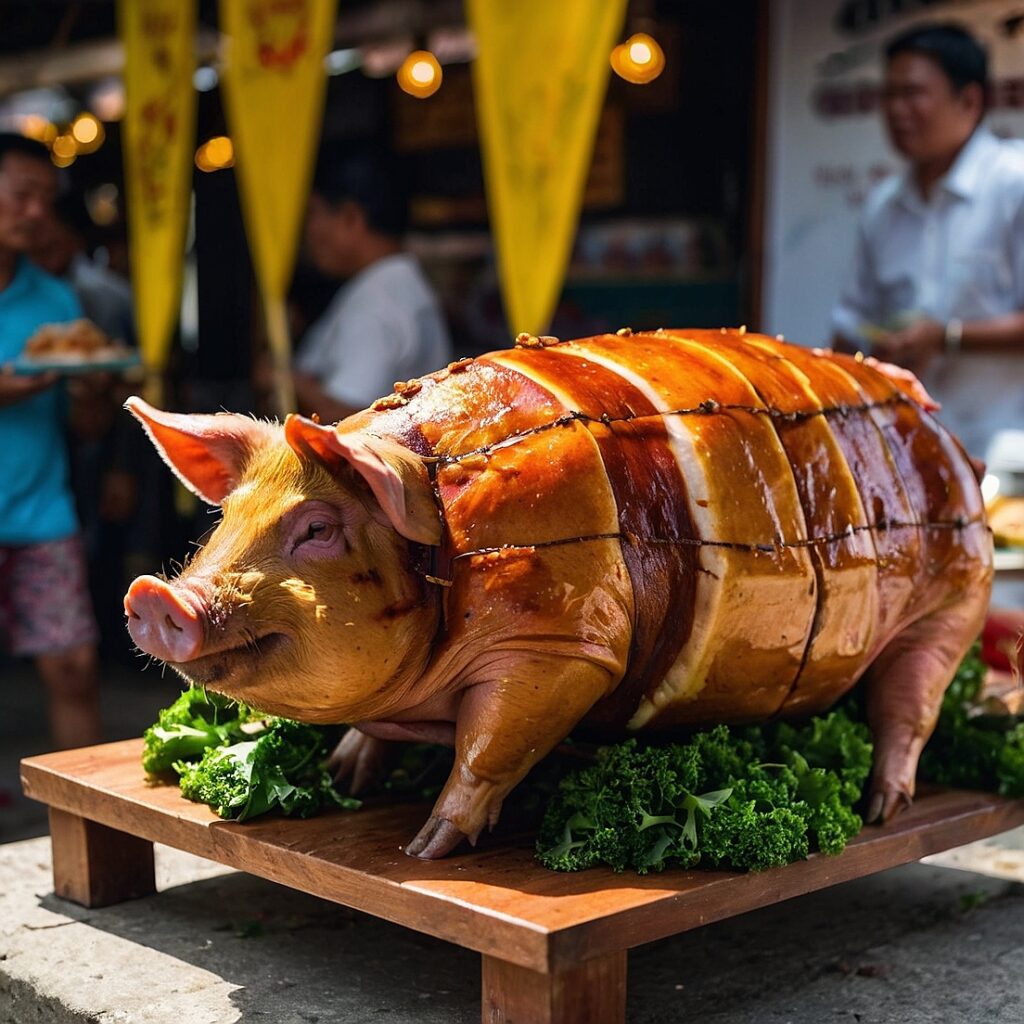Have you ever wondered what it would be like to step into a world where art comes alive on human canvases? Well, look no further than the enchanting Pintados de Passi Festival in Iloilo, Philippines! This captivating celebration of body painting traditions is a feast for the eyes and a journey through time, connecting us to the rich cultural heritage of the region. In this blog post, we’ll dive deep into the colorful world of Pintados de Passi, exploring its history, significance, and the incredible artistry that makes it a must-see event for locals and tourists alike.
As we embark on this exciting exploration, prepare to be amazed by the intricate designs, vibrant colors, and the sheer creativity that transforms ordinary people into living works of art. From its humble beginnings to its current status as a major cultural attraction, the Pintados de Passi Festival has a story that’s as fascinating as the body paintings themselves. So, grab a cup of coffee, sit back, and let’s unravel the captivating tapestry of this unique Filipino celebration!
The Origins of Pintados: A Glimpse into Ancient Filipino Culture
To truly appreciate the Pintados de Passi Festival, we need to take a step back in time and understand the roots of this incredible tradition. The term “pintados” actually dates back to the pre-colonial era of the Philippines, long before the Spanish arrived on these shores. It refers to the tattooed warriors of the Visayas region, known for their intricate body art that covered much of their skin.
These ancient tattoos weren’t just for show – they held deep cultural and spiritual significance. Each design told a story, representing the wearer’s status, achievements, and even their spiritual beliefs. The more tattoos a warrior had, the more respected and feared they were in their community. It was a badge of honor, a living testament to their bravery and accomplishments.
When the Spanish conquistadors first encountered these tattooed warriors in the 16th century, they were so struck by their appearance that they dubbed the islands “Isla de los Pintados” or “Island of the Painted Ones.” This name stuck, becoming an integral part of Filipino history and cultural identity.
The Evolution of Pintados
As time passed and colonization changed the cultural landscape of the Philippines, the practice of full-body tattooing gradually faded. However, the spirit of the pintados lived on in the collective memory of the Filipino people. It wasn’t until the late 20th century that this ancient tradition found new life in the form of festivals and celebrations, with the Pintados de Passi Festival being one of the most prominent.
The revival of pintados through festivals like this one serves as a powerful reminder of the Philippines’ rich pre-colonial heritage. It’s a way for modern Filipinos to connect with their ancestors, to celebrate their unique cultural identity, and to showcase their creativity and artistry to the world.
The Birth of Pintados de Passi: From Local Celebration to Cultural Phenomenon
Now that we’ve delved into the historical roots of pintados, let’s fast forward to the birth of the Pintados de Passi Festival itself. This vibrant celebration didn’t just appear out of thin air – it’s the result of passionate individuals and a community coming together to honor their heritage in a truly spectacular way.
The Pintados de Passi Festival was first conceptualized in the early 2000s by a group of local artists and cultural enthusiasts in Passi City, Iloilo. They were inspired by the success of similar festivals in other parts of the Philippines, such as the Pintados-Kasadyaan Festival in Tacloban City, Leyte. However, they wanted to create something unique that would showcase the specific cultural identity of Passi and the surrounding region.
From Vision to Reality
The inaugural Pintados de Passi Festival took place in 2005, marking the beginning of what would become an annual tradition. The first festival was a relatively small affair, with just a handful of participants and mostly local spectators. But even in its infancy, the festival showed incredible promise, captivating audiences with its colorful body paintings and lively performances.
Word of this unique celebration quickly spread, and with each passing year, the Pintados de Passi Festival grew in size and scope. More participants joined in, the designs became more elaborate, and visitors from all over the Philippines – and eventually, from around the world – began to flock to Passi City to witness this spectacular event.
What started as a local initiative to preserve cultural heritage soon blossomed into a full-fledged cultural phenomenon. The festival not only put Passi City on the map as a tourist destination but also played a crucial role in reviving interest in traditional Filipino body art and its associated rituals and meanings.
The Art of Pintados: A Canvas of Culture and Creativity
At the heart of the Pintados de Passi Festival lies the incredible artistry of body painting. This isn’t your average face painting at a county fair – we’re talking about full-body masterpieces that transform participants into living, breathing works of art. Let’s take a closer look at what goes into creating these stunning designs and the meaning behind them.
The Process: From Blank Canvas to Masterpiece
Creating a pintados design is no small feat. It typically takes several hours of meticulous work to complete a single participant’s body art. The process usually begins early in the morning on the day of the festival, with teams of artists working tirelessly to bring their visions to life.
The first step is to sketch out the design on the participant’s body using a light-colored pencil or chalk. This serves as a guide for the more detailed work to come. Once the outline is in place, the artists begin applying the paint using a variety of tools, from brushes of different sizes to sponges and even their own fingers for more intricate details.
The paints used are specially formulated for body art, ensuring they’re safe for the skin and vibrant enough to stand out under the bright Filipino sun. A wide range of colors is employed, with each hue chosen carefully to represent different aspects of the design’s symbolism.
Symbolism and Storytelling in Pintados Designs
While the designs at the Pintados de Passi Festival are undoubtedly beautiful to look at, they’re much more than just pretty pictures. Each design tells a story, often drawing inspiration from various aspects of Filipino culture, history, and mythology. Here are some common themes you might spot in the pintados designs:
- Nature and wildlife: Many designs feature elements of the Philippines’ rich biodiversity, from exotic flowers to native animals.
- Tribal patterns: Intricate geometric patterns reminiscent of traditional tattoo designs are a staple of pintados art.
- Historical scenes: Some participants choose to depict important moments from Filipino history on their bodies.
- Mythological creatures: Beings from Filipino folklore, such as the half-human, half-horse tikbalang, often make appearances in pintados designs.
- Religious imagery: Given the strong influence of Catholicism in the Philippines, some designs incorporate religious symbols and figures.
- Modern interpretations: Contemporary artists often blend traditional elements with modern artistic styles, creating unique and innovative designs.
The beauty of pintados art lies not just in its visual appeal, but in its ability to convey complex cultural narratives through a single, cohesive design. It’s a testament to the skill and creativity of the artists involved, as well as the rich cultural tapestry they draw inspiration from.
The Festival Experience: More Than Just Body Painting
While the body painting competition is undoubtedly the star of the show, the Pintados de Passi Festival offers so much more to visitors. It’s a multi-day extravaganza that showcases various aspects of Ilonggo culture and provides entertainment for all ages. Let’s take a virtual tour through the festival grounds and explore what you can expect if you’re lucky enough to attend.
Parades and Street Dancing
One of the most exciting parts of the festival is the grand parade, where participants show off their elaborate body paintings while dancing through the streets of Passi City. The parade is a riot of color and movement, with each group trying to outdo the others in terms of creativity and performance.
The street dancing competition is a particular highlight, combining the visual spectacle of the pintados designs with high-energy choreography set to pulsing music. It’s a feast for the senses that never fails to get the crowd cheering and dancing along.
Cultural Performances and Exhibitions
Throughout the festival, various stages and venues host cultural performances that showcase traditional Ilonggo music, dance, and theater. These performances offer visitors a deeper look into the rich cultural heritage of the region, going beyond the pintados tradition to explore other aspects of local folklore and customs.
You’ll also find exhibitions of traditional crafts, where local artisans demonstrate their skills in weaving, pottery, woodcarving, and other traditional art forms. It’s a great opportunity to pick up unique souvenirs and support local craftspeople.
Food Festival
No Filipino celebration would be complete without food, and the Pintados de Passi Festival doesn’t disappoint in this regard. A food festival runs concurrently with the main event, offering visitors a chance to sample a wide array of Ilonggo delicacies and Filipino favorites.
From savory dishes like La Paz Batchoy (a hearty noodle soup) and Chicken Inasal (grilled chicken marinated in local spices) to sweet treats like Barquillos (rolled wafer cookies) and Pinasugbo (deep-fried banana strips), there’s something to satisfy every palate. It’s the perfect way to refuel between watching performances and exploring the festival grounds.
Workshops and Demonstrations
For those interested in learning more about the art of body painting or other aspects of local culture, the festival often includes workshops and demonstrations. These interactive sessions allow visitors to try their hand at simple body painting techniques or learn about other traditional arts and crafts.
It’s a fantastic opportunity for cultural exchange, where visitors can engage directly with local artists and gain a deeper appreciation for the skills and traditions being celebrated.
The Impact of Pintados de Passi: Preserving Heritage and Boosting Tourism
The Pintados de Passi Festival isn’t just a fun annual event – it has had a significant impact on both cultural preservation and the local economy. Let’s explore how this colorful celebration has become a powerful force for positive change in Passi City and beyond.
Cultural Preservation and Revival
One of the most important aspects of the Pintados de Passi Festival is its role in preserving and reviving traditional Filipino culture. By bringing ancient body painting traditions into the spotlight, the festival has sparked renewed interest in pre-colonial Filipino art forms and practices.
This revival extends beyond just the festival itself. Many young artists who participate in or attend the festival have been inspired to delve deeper into their cultural roots, leading to a resurgence of interest in traditional tattooing and other indigenous art forms. Schools in the region have even started incorporating lessons about pintados and other pre-colonial traditions into their curricula, ensuring that this cultural knowledge is passed on to future generations.
Economic Impact and Tourism Boost
The festival has also had a significant positive impact on the local economy of Passi City and the surrounding areas. Let’s take a look at some impressive statistics:
| Year | Estimated Visitor Numbers | Estimated Economic Impact |
|---|---|---|
| 2015 | 50,000 | ₱15 million |
| 2017 | 75,000 | ₱25 million |
| 2019 | 100,000 | ₱35 million |
| 2021 | 25,000 (virtual event) | ₱5 million |
As we can see, the festival has been a major draw for tourists, bringing in tens of thousands of visitors each year (with the exception of 2021, when the COVID-19 pandemic necessitated a scaled-down virtual event). This influx of visitors translates into significant economic benefits for the local community, from increased hotel bookings and restaurant sales to opportunities for local artisans and performers to showcase and sell their work.
The success of the Pintados de Passi Festival has also put Passi City on the map as a cultural tourism destination, encouraging visitors to explore other attractions in the area and potentially extending their stay in the region.
Community Pride and Social Cohesion
Beyond the economic benefits, the festival has played a crucial role in fostering community pride and social cohesion in Passi City. The event brings together people from all walks of life – artists, performers, local government officials, business owners, and ordinary citizens – in a shared celebration of their cultural heritage.
This sense of shared purpose and pride has had ripple effects throughout the community, inspiring other cultural initiatives and encouraging greater civic participation. The festival has become a symbol of Passi City’s identity, something that locals can point to with pride when talking about their hometown.
The Future of Pintados de Passi: Challenges and Opportunities
As we look to the future, the Pintados de Passi Festival faces both challenges and exciting opportunities. Let’s explore what lies ahead for this beloved cultural celebration and how it might evolve in the coming years.
Balancing Tradition and Innovation
One of the ongoing challenges for the festival organizers is striking the right balance between honoring traditional pintados designs and encouraging innovative, contemporary interpretations. While it’s crucial to preserve the historical significance of the art form, there’s also a need to allow it to evolve and remain relevant to younger generations.
Moving forward, we can expect to see more fusion designs that blend traditional motifs with modern artistic styles. This evolution could help attract a wider audience and keep the festival fresh and exciting year after year.
Environmental Considerations
As awareness of environmental issues grows, there’s increasing pressure on festivals worldwide to reduce their ecological footprint. For the Pintados de Passi Festival, this might mean exploring more eco-friendly body paint options, implementing better waste management systems, and finding ways to minimize the environmental impact of the influx of visitors.
These challenges also present opportunities for innovation. For example, the festival could partner with local environmental groups to educate visitors about conservation efforts in the region, or showcase sustainable traditional practices that are part of Ilonggo culture.
Expanding the Festival’s Reach
While the Pintados de Passi Festival has already grown significantly since its inception, there’s still potential for it to reach an even wider audience. The successful pivot to a virtual format in 2021 due to the COVID-19 pandemic demonstrated the possibility of engaging with a global audience through digital platforms.
Moving forward, we might see a hybrid approach that combines the in-person festival experience with digital elements. This could include live streaming of key events, virtual tours of the festival grounds, or online workshops that allow people from around the world to participate in some aspects of the celebration.
Fostering Cultural Exchange
As the festival continues to attract international attention, there’s an opportunity to use it as a platform for broader cultural exchange. We might see collaborations with body painting artists from other cultures, creating a dialogue between different artistic traditions and fostering mutual understanding and appreciation.
This could elevate the Pintados de Passi Festival from a local celebration to a global event that showcases not just Filipino culture, but the diversity of body painting traditions from around the world.
The Enduring Appeal of Pintados de Passi
As we wrap up our colorful journey through the world of the Pintados de Passi Festival, it’s clear that this celebration is so much more than just a feast for the eyes. It’s a living, breathing testament to the resilience of Filipino culture, a bridge between the past and the present, and a canvas for endless creativity and expression.
From its roots in ancient tattooing traditions to its modern incarnation as a vibrant festival, Pintados de Passi has captured the hearts of locals and visitors alike. It’s a reminder of the power of art to bring people together, to tell stories, and to keep cultural traditions alive in an ever-changing world.
Whether you’re an art enthusiast, a culture buff, or simply someone who loves a good celebration, the Pintados de Passi Festival offers something truly unique. It’s an opportunity to witness the transformation of human bodies into works of art, to immerse yourself in the rich tapestry of Filipino culture, and to be part of a community coming together in joyous celebration.
So, why not add the Pintados de Passi Festival to your travel bucket list? Come and experience the magic for yourself, and who knows – you might just find yourself inspired to become a living canvas, carrying on this beautiful tradition for generations to come!
Disclaimer: The information in this blog post is accurate to the best of our knowledge as of April 2021. However, festival dates, events, and other details may change from year to year. We encourage readers to check the official Pintados de Passi Festival website or contact local tourism authorities for the most up-to-date information before planning their visit. If you notice any inaccuracies in this post, please let us know so we can correct them promptly.




